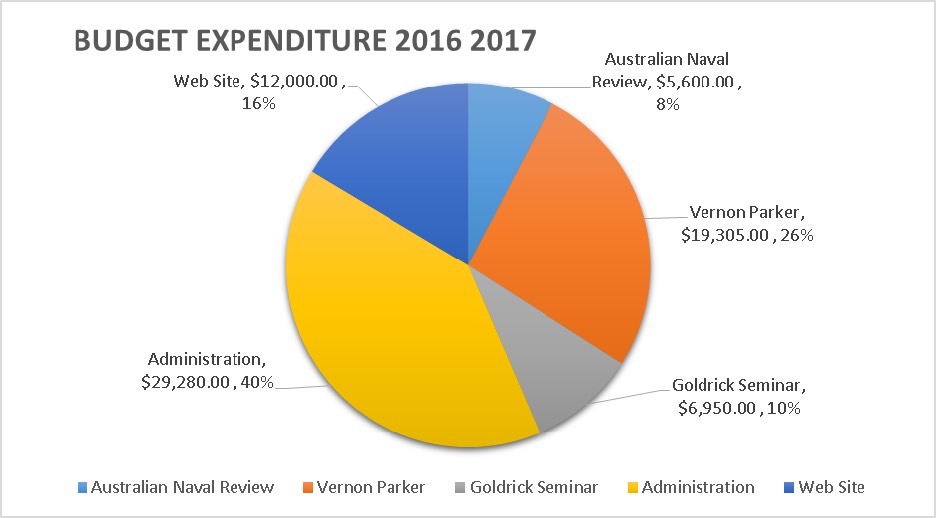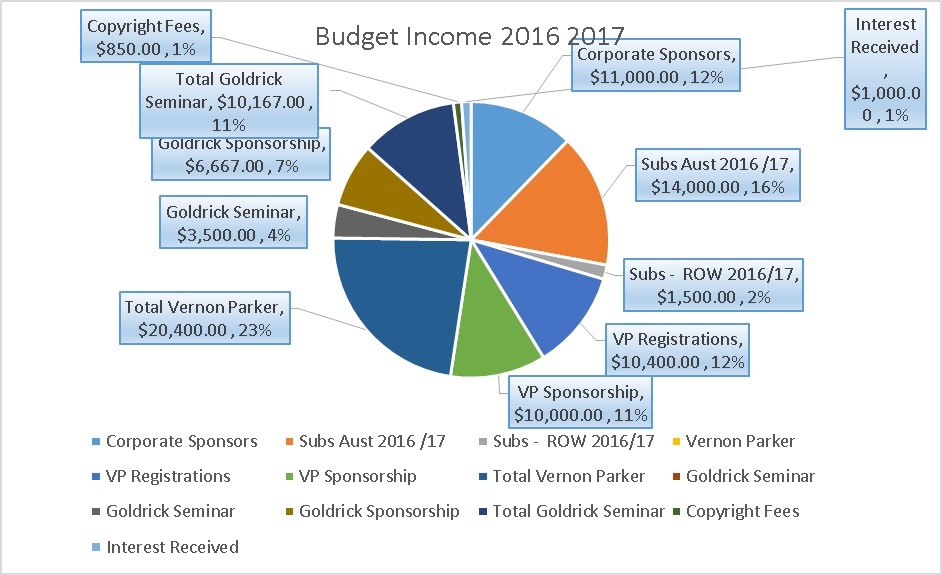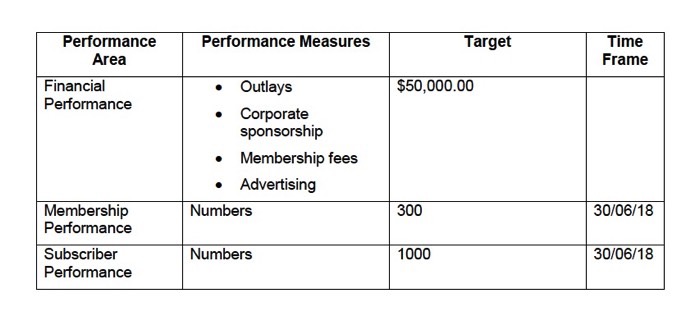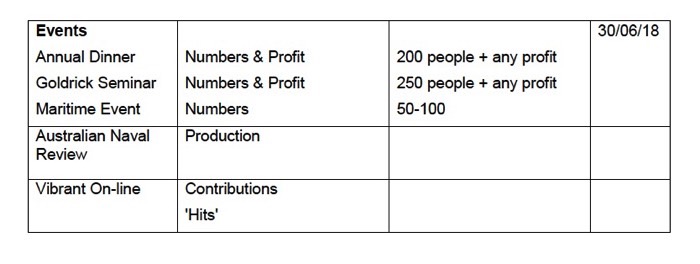A PDF version of this document can be downloaded by clicking here.
 Overview
Overview
The Australian Naval Institute (ANI) is an independent not-for-profit organisation, incorporated in the Australian Capital Territory. It has been in existence since 1975 and its role is to:
a. Encourage and promote the advancement of knowledge related to the Navy and the maritime profession, and
b. Provide a forum for the exchange of ideas concerning subjects related to the Navy and the maritime profession.
This strategic plan builds on the 2008-2013 and 2012-2015 strategic plans, recognising the contemporary environment in which the ANI is operating, and aims to guide the activities of the Institute over the next three to five years and provide a framework upon which the Council can base decisions. It also sets goals against which the ANI can assess its performance.
A major focus of both earlier Strategic Plans was the production of the ANI journal – Headmark. In face of rising costs the Council in 2014 decided to cease publication and focus on on-line content. The last Headmark was produced in early 2015 with the prospect of an annual peer reviewed journal – The Australian Naval Review – to be first published in 2016.
The 2016-2018 Strategic Plan outlines how the ANI will make that transition to a more on-line engagement with its members and subscribers to its website.
Mission
The mission of the Australian Naval Institute is to be the pre-eminent naval professional association that fosters the discourse of Australian naval and maritime affairs.
Organisational Values and Signature Behaviours
The ANI’s core organisational values and signature behaviours are those of the Royal Australian Navy. They are:
Values
Honour
Integrity
Loyalty
Courage
Honesty
Signature Behaviours
Respect the contribution of every individual
Promote the wellbeing and development of Navy people
Communicate well and regularly
Challenge and innovate
Be cost conscious
Fix problems, take action
Drive decision making down
Strengthen relationships across & beyond Navy
Be the best I can
Make Navy proud, make Australia proud.
Environment
The environment in which the ANI will operate over the next three years will be largely characterised by fiscal constraint as it completes the transition to the new operating model.
Increasingly corporate sponsors look for tangible benefits for their support and continuation of long standing associations cannot be taken for granted. It will be important to maintain good communication with sponsors and members to ensure their continued support during this critical period.
Planned Operating Model 2016-2018
The ANI’s planned operating model for 2016-2018 is to:
a. Maintain a dynamic website with regular additions of content of broad naval and maritime affairs, on-line discussions and book reviews. Most content is available via free subscription and full content available for members.
b. hold an annual dinner in Canberra with its centrepiece being the Vernon Parker Oration delivered by a distinguished Australian.
c. hold a one-day Goldrick Seminar in Canberra in the second half of the year which would discuss a topical naval topic.
d. Produce initially annually but eventually three times a year The Australian Naval Review which will be a peer reviewed journal on Australian maritime affairs
e. Hold at least one maritime event preferably associated with the Fleet or Fleet Air Arm.
f. Present a range of prizes for excellence to naval officers and sailors. Potentially in the future these prizes will include for excellence in industry support to the Navy and media reporting of naval matters.
This operating model is underpinned by the administrative support provided by Commerce Management Services.
Finances
The financial base of the ANI underpins its capacity to advance its mission. The last independent audit has assessed the financial status of the Institute as ‘strong’. The ANI holds in equity approximately two years of expected income to cover operating costs.
To better align the ANI with its sponsors in 2015 the ANI moved from a calendar year to financial year operations. The following figures display the income and expenditure for the calendar year 2015.
Sponsorship remains the principal source of the ANI’s income, and is the main source of funding for the Institute’s principal activities. It the current environment, it will be important to ensure that our sponsors are provided with recognition and the exposure they reasonably seek for their contributions to the Institute’s endeavours. In 2015 the ANI offered naming rights for the Goldrick Seminar and this was positively received.
Membership fees are the other major source of the ANI’s income. As a minimum, fees will need to cover the costs of benefits extended to members of the Institute and a small premium that contributes to achievement of the mission. This represents a balance between the financial requirements of the ANI and value for money proposition potential members will contemplate. For this reason, the benefits of membership need to remain foremost among considerations of the Council. This is particularly the case with cessation of Headmark.
It has taken some time for the ANI to adjust its budget to align with the new operating model. What is clear from an examination of the finances is that during this period that both membership and sponsorship income will be fundamental to realize the ANI’s objectives.
The routine business of the ANI also needs to be conducted with as much acumen as enthusiasm. Decisions concerning merchandise for example, must be attended with due consideration for the benefit in relation to the cost. Naturally, this applies to all decisions that commit the funds of the Institute.
Membership
A stable and ideally growing membership base is important to the ANI. Membership is a central feature of the ANI as articulated in the Constitution and it is from the membership base that the Council is drawn.
At the beginning of 2016, the ANI had 246 financial members and 660 website subscribers.
The value proposition for members is that they will receive for their membership:
a. Full access to the ANI Website,
b. A hard and electronic copy of The Australian Naval Review,
c. Discount to all ANI events,
d. Discounts to US Naval Institute journal and publications; and
e. Discounts to non-ANI books and events as arranged by the ANI Council.
Sponsorship
A tiered sponsorship program has been adopted which can be tailored in discussion with prospective sponsors. The levels are:
PLATINUM – $12,000.00/ year ($21,000.00/ 2 years – $30,000.00/ 3 years)
Commit to 3 years, pay per year: $10,000
Recognition
Sponsorship naming rights at the annual Goldrick seminar
15 x Membership access to ANI web site
Corporate Logo on main Menu of ANI Web Site with link to corporate web site
Corporate banners can be placed at all events
Events
One (1) seat at the head table of the annual Oration Dinner
Corporate Table of five (5) people at Oration Dinner
Input towards the theme for the annual Maritime Event Seminar
Participation at the annual ANI Maritime Event Seminars
Speaker at the annual Goldrick seminar
Literature
Full page advertisement in the annual Australian Naval Review from 2016 (sponsor provide camera ready artwork)
The posting of up to Five (5) published articles featured on the ANI web page
Author contributions to the ANI monthly forums
GOLD – $8,000.00/ year ($14,000.00/ 2 years – $21,000.00/ 3 years)
Commit to 3 years, pay per year: $6,500
Recognition
Naming rights at an Annual Maritime Event Seminar
10 x Membership access to ANI web site
Corporate Logo on main Menu of ANI Web Site with link to corporate web site
Corporate banners can be placed at all events
Events
Support of Dinners (Drinks – Dinner)
Participation in the ANI Annual Maritime Event Seminar
Speaker at the annual Goldrick seminar
Three (3) seats at the annual Oration Dinner
Literature
1/2 page advertisement in the Australian Naval Review (sponsor to provide camera-ready artwork)
Three (3) published articles featured on the ANI web page
Author contributions to the ANI monthly forum.
SILVER – $5,000.00/ year ($9,000.00/ 2 years – $14,000.00/ 3 years)
Commit to 3 years, pay per year: $4,000.00
Recognition
10 x Membership access to ANI web site
Corporate Logo on main Menu of ANI Web Site with link to corporate web site
Display Corporate banners at all events
Events
Support of Dinners (Drinks – Pre Dinner)
Participation in the ANI annual Maritime Event Seminar
Speaker at the annual Goldrick seminar
Two (2) seats at the annual Oration Dinner
15% discount for a Corporate table of 4 or more people
Literature
1/3 page advertisement in the Australian Naval Review
One (1) published articles featured on the ANI web page
Author contributions to the ANI monthly editorial debate
FELLOWSHIP – $2,000/ Year ($5,000.00/ 3 Years)
Commit to 3 years, pay per year: $1,666.00
Listed as a “Fellowship” member on the ANI website;
10% Discount participation at events
Attendance in Maritime Event Seminars
¼ page Advertisement in Australian Naval Review
5 x Membership access to ANI web site and link to corporate web site
15% discount for a Corporate table of 4 or more people
CORPORATE – Membership $950/ Year ($2,500.00/ 3 Years)
Commit to 3 years, pay per year: $833.00
Listed as a “Corporate” member on the ANI website;
2 x Membership access to ANI web site;
10% Discount participation at all events;
Recognition on ANI Web Site and link to corporate web site; and
Acknowledgement in Australian Naval Review.
The ANI Website
With the cessation of Headmark, the website and associated email alerts has assumed greater importance. It is the primary means to disseminate information and encourage discussion.
It is the intention to maintain a tiered access approach. The majority of the website will be accessible to subscribers. In this way discussion can be fostered and ideas disseminated. There are approaching 700 subscribers and this growth needs to be encouraged with possible cross-linking with social media channels.
It will be important for the website to be regularly maintained and for it to have a professional and ‘contemporary’ feel.
The Australian Naval Review (ANR)
The objective of the ANR is to be a learned peer reviewed journal. To attain this goal it will be necessary to establish an editorial committee to solicit, review and oversee the editing of the Review.
The intent is to produce a black and white, perfect bond publication that is also available in electronic form.
Events
Events are a complementary, yet key, means by which the ANI advances its mission. They need to strike the right balance between prominence and affordability, noting their central connection to the mission and potential to attract audiences of significance.
The timing of these events synchronises with the strategic calendar in Canberra, meaning there is not competition for attendance with events hosted by other organisations.
The ANI will leverage its association with other institutes and organisations to promote its events, seeking their assistance to advertise to their membership. The Institute will also use the assistance of its own membership to advertise events alongside web-based promotional efforts.
Organisational Capabilities
A large cross section of the ADF and broader community is represented across the ANI membership. This includes current and former members of the ADF, maritime enthusiasts and a small overseas contingent. This large representation provides the Institute and its members with a large resource pool from which to elect Councillors. The role of the Council is to develop the ANI over the following areas:
1. strategic leadership and vision,
2. planning,
3. execution,
4. financial management, and
5. promotion.
A continuing issue for Council members is available time to commit to ANI activities. As stated in the previous strategic plan, there is an implied expectation of Council members to commit sufficient time to managing the Institute. Several Council members have been appointed for specific tasks such as the President and Vice-President, as well as the Treasurer and Public officer.
To facilitate the execution of the ANI activities The Council will have five sub-committees that will cover:
a. finance, governance and sponsorship
c. membership, communications and prizes
d. events
e. website and social media
f. the Australian Naval Review.
Goals of 2016-2018 Strategic Plan
The ANI Council during 2016-18 has the following high priority goals:
a. Goal One: By 30 June 2018 have achieved an operating surplus.
b. Goal Two: By 1 December 2016 have produced the inaugural edition of the Australian Naval Review.
c. Goal Three: By 30 June 2018 have 300 ANI members.
d. Goal Four: By 30 June 2018 have developed a vibrant on-line presence with 1,000 subscribers.
e. Goal Five: By 30 June 2018 have established a program of events of an Annual Dinner, Goldrick Seminar and one Fleet orientated maritime event.
f. Goal Six: By December 2016 have established coordination with other kindred Defence and maritime organizations with a view to co-host events.
Performance Objectives
The performance objectives below, in combination, form a performance scorecard for easily tracking the performance improvements generated by this plan.
Enclosures:
1. ANI Value Proposition
2. ANI Communications Plan
AUSTRALIAN NAVAL INSTITUTE
‘VALUE PROPOSITION’
The ANI is an internationally recognized and professionally administered navalprofessional naval institution that has been in existence for 40 years.
Its Patron is the Chief of Navy.
The Subscriber base to its website Lismore than 7000 individuals or organisations. Newcontent is regularly notified to subscribers to encourage readership.
Membership is around 250 individuals or organisations.
The Institute’s objective is to provide a forum for discussion of naval and strategicmatters. It is consciously forward looking but will encourage the discourse of navaland strategic history where it provides context for the future.
As part of encouraging discussion the Institute is keen to bring people from the Navy,industry, academia and the broader interested community together to shareperspectives and enrich thought and discussion. This is a major strength of theInstitute.
The Institute’s activities include:
Annual Dinner in Canberra where the Vernon Parker Oration is given by adistinguished figure in naval, strategic or national affairs. Previous speakers haveincluded Dr Brendon Nelson, Chiefs of the RAN and foreign navies.
Annual Goldrick seminar in Canberra toward end of the year. This series has a focuson providing a forum on a particular topic with a panel of experts to lead the discussion.
Lectures on an opportunity basis by distinguished leaders and thought-leaders innaval and strategic affairs.
Seminars on naval and maritime affairs, generally held in Sydney or other navalcentres outside Canberra.
Co-sponsor conference or seminars in conjunction with the Navy or other kindredmaritime and strategic institutions.
Provides a series of prizes to graduates of the Navy’s training institutions.
Use of ANI website as forum on naval and maritime affairs.
The Institute has regularly reinvigorated itself in the face of the changing naval an dstrategic landscape, members’ needs and technology. The ANI sin one of the invigoration phases at present.
Future plans for the Institute are:
Development of a annual peer review Journal of international standing.
Greater public engagement on naval affairs. This will take advantage of the recentchange to the Institute’s constitution whereby former RAN members hold Councilpositions and therefore freer to comment. As part of this initiative a publicengagement strategy is being developed.
Reinvigorate its partnership with industry sponsors.
Institute a media award for excellence of reporting in naval affairs. The award will bepresented at the annual dinner. The overall objective is to encourage improvedreporting of the naval sphere.
Development of a membership strategy to provide an enhanced value proposition forindividual and corporate membership.
Further enhancements to the ANI website.
Greater outreach to the naval community beyond Canberra this will be throughseminars and the internet.
These initiatives will ensure that the ANI is the pre-eminent institute devoted toencouraging informed discussion of naval and related strategic issues in Australia.
ANI COMMUNICATIONS PLAN 2016-2018
Introduction
1.This document details how the ANI will inform and educate a broad audienceon the role of the ANI and advance knowledge related to the Royal Australian Navy (RAN) and the maritime profession. It is informed by and supports the ANI Strategic Plan 2016-18 and supports the ANI value proposition.
2.An effective communications plan is key to achieving the aims of the ANIStrategic Plan. The communications plan not only details how the ANI will communicate its key messages on naval and maritime affairs, but also how it will promote its own visibility in order to achieve this messaging to a wide audience. The most important message means nothing if no-one reads or hears it.
3.An effective communications plan is also central to recruiting for the ANI, asactive membership is seen as a critical to the success of the ANI.
Aim
4 The Aim of the ANI Communication Plan is to inform and educate Australians on the role of the ANI and on the importance of the RAN and maritime affairs.
Objectives
5.The objectives of the ANI Communications Plan are to:
Build awareness of the role of the ANI domestically and internationally.
Build awareness of the RAN and maritime affairs.
Build awareness of the forums available for the exchange of ideas on navaland maritime affairs.
Encourage the advancement of knowledge related to the Navy and maritimeprofession.
Secure the commitment of senior Navy personnel to help achieve a greaterawareness of the Navy and maritime affairs.
Key messages
6.The key messages of the ANI Communications Plan reflect the dual nature ofthis plan, and are:
The ANI is an internationally recognised and professionally administerednaval professional naval institution that can offer significant assistance toindividuals and organisations/industry in debating or discussing their keymessages or ideas.
Australian Naval Institute Strategic Plan 2016-2018
The maritime domain is critical to the survival of Australia’s economy, and aneffective navy is critical to protecting this maritime economy and Australia’sinterests.
A navy can conduct a wide spectrum of tasks and can maintain presence farfrom Australia’s coast to protect Australia’s interests.
The Royal Australian Navy (RAN) is a critical element of Australia’s history.
The open exchange of ideas on naval and maritime affairs is critical todeveloping and improving the RAN and Australia’s naval and maritimeindustry and profession.
The engagement of ex and serving Navy personnel of all ranks in the ANI iscritical to building awareness and interest in naval affairs.
The engagement of the other services, industry and academia in the ANI iscritical to building awareness and interest in naval affairs.
Target Audiences
7.Given the role of the ANI and the key messages, the target audience is broadin type and size. The target audience is (not in order of importance):
Serving RAN officers, senior sailors and junior sailors.
Ex-RAN officers, senior sailors and junior sailors.
Other members of the ADF and APS,
Defence Industry.
Academia, not limited to defence and foreign affairs.
The media.
The general civilian population.
Communication management plan
8.Communication objectives will be achieved through the following types ofactivities:
Print and electronic media articles on core ANI aims/messaging, such as theANR, other journals, commentary, ANI website, ANI blogs and twitter.
Payed and free print and electronic media articles or advertising on theexistence and role of the ANI, such as in Navy News (and Army and RAAF
Australian Naval Institute Strategic Plan 2016-2018
News), defence journals, ANI website and links from other websites (these will offer the best value for money).
Events and speeches on core ANI aims, such as Goldrick Seminar and theannual oration dinner.
Letters and correspondence from the ANI President direct to targeted interestgroups and audience, such as letters to the editor or in journals.
Sponsorship and awards, both public and defence/Navy.
Where appropriate, the effective use of such internal Navy programs as CPDto further interest and the aims of the ANI.
Resources
9.To conduct an effective ANI Communications Plan there will be a need for anadditional budget allocation on cost-effective advertising.
Evaluation
10.This Communications Plan will be monitored by the ANI Council, which willinclude moneys spent and KPIs such as, but not limited to, Website hits, traditional column inches, advertising and sponsorship income, and attendance at functions or seminars. The measures of effectiveness are more complex but would ideally include overall ANI membership (ie growth), and the type of contributors to journals and the seniority of those attending functions and events (ie influence).







